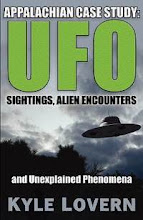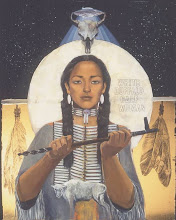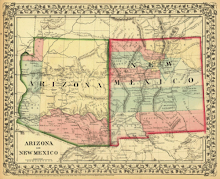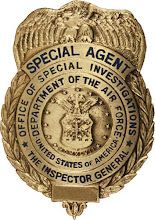Saturday, November 28, 2009
New book reports UFO encounters in Appalachia
By Steve Hammons
Eyewitness accounts of UFO sightings and strange encounters in the Appalachian Mountain region provide fascinating reading in a recently-published book by researcher, journalist and author Kyle Lovern.
Volume 2 of "Appalachian Case Study: UFO Sightings, Alien Encounters & Unexplained Phenomena" continues the exploration that Lovern began in the first volume, published in 2008.
Lovern brings a solid journalistic background to this challenging topic and the complex related factors involved.
He is an award-winning journalist from southern West Virginia with a background in newspaper work as an editor, columnist, reporter and photographer, recognized for his writing and photography. He has also worked in radio.
Recently freelancing for the Charleston Daily Mail, one of the state’s largest newspapers, Lovern also recently received first and third place awards in the 2008 West Virginia Press Association newspaper contest. As a reporter, he has also covered county and state sporting events. For several years he was a popular newspaper columnist in southern West Virginia and eastern Kentucky.
Lovern is a graduate of Southern West Virginia Community College and Bluefield State College. His work has also been featured in Wild, Wonderful West Virginia magazine, Goldenseal magazine of West Virginia traditional life and Marshall Magazine (Marshall University).
While Volume 1 of "Appalachian Case Study: UFO Sightings, Alien Encounters & Unexplained Phenomena" focused entirely on incidents in his home state of West Virginia, Lovern’s new book also goes outside that state’s borders to examine cases related to the Appalachian region of bordering states such as Virginia and Kentucky.
Lovern brings the objectivity and straightforward writing of an experienced journalist to the topic of unusual phenomena that is so needed in our society today. Like all good journalists, he looks at and tries to document important elements of a journalist’s main targets: the “who, what, when, where, why and how.”
MULTIPLE VIEWPOINTS
As with his earlier book, Volume 2 takes readers through the reports by down-to-Earth average people from different walks of life who have experienced something apparently quite interesting.
In addition, insightful quotes from famous public figures introduce each chapter and provide thought-provoking statements linked to UFOs and other unusual phenomena. Lovern uses quotes from astronauts Neil Armstrong, Edgar Mitchell and Gordon Cooper (Armstrong, an Ohio native, currently lives in Cincinnati, near the western Appalachian region).
Fascinating and sometimes cryptic statements by Sen. Barry Goldwater, Gen. Douglas McArthur and long-time FBI chief J. Edgar Hoover also lead readers into each chapter. Presidents Ronald Reagan, Bill Clinton and Richard Nixon are also quoted.
Scientists Albert Einstein, Stephen Hawking, J. Allen Hynek (an official U.S. Air Force UFO investigator with the Dayton, Ohio-based “Project BLUE BOOK”) and Harvard psychiatrist John Mack, M.D., provide similar insights. (Mack became well-known for his research into alleged abductions of humans by non-human beings.)
We even hear from filmmaker Steven Spielberg as we delve into one of Lovern’s chapters.
Each chapter is a detailed account of a particular incident, carefully taken from the statements of eyewitnesses and individuals who directly experienced it, as well as reporting by the news media. In many cases, there were multiple witnesses to the incidents. In some instances, local public safety personnel were involved.
For example, in Chapter 2, a community college psychology professor and his two teenage sons were driving home one evening in 2003 near Morehead, Kentucky, and clearly saw an oval-shaped object or craft in the sky nearby. They also observed “dazzling” bright lights near the object.
Meanwhile, local police were getting calls from local residents of a woman screaming.
Upon arriving home, the college professor and his sons soon were visited by peace officers checking the neighborhood for a possible woman in distress. Soon, approximately 20 public safety, rescue and law enforcement personnel were searching a nearby field where the oval-shaped object had been seen by multiple witnesses.
It’s unknown to the professor and his sons what happened to the UFO. A woman in distress was apparently never located.
DANGERS OF ENCOUNTERS
The potential dangers of encounters with UFOs were part of Lovern’s account of a sad and touching report of a young boy who had apparent close contact with a beam of strange light from an airborne source or craft, and who died of a brain tumor approximately one year later.
The 11-year-old boy’s family had moved from their home state of West Virginia to Detroit, Michigan, and in 1993 the boy and his friend were in the yard during a heavy snowstorm building a snow fort to play in.
Suddenly, an “aircraft” of some kind hovered approximately 50 feet above the boys and two beams of light flashed down on them. One light was reported to be yellow and the other blue, according to the boys’ statements. An adult neighbor and other witnesses also saw the lights.
The boys were quite frightened, and shortly afterward developed an unusual rash all over their bodies, as well as other physical problems. Their emotional reactions to the incident were described as terror and fear.
But much more serious than these outcomes was the subsequent diagnosis of a brain tumor in the boy from West Virginia. He passed on from this medical condition in 1994.
Did the brain tumor have something to do with the UFO? We will probably never know. But, there have been other reports of UFO witnesses developing symptoms similar to radiation poisoning.
In Chapter 13, the potential dangers of close encounters are again noted in the account of three women driving through Kentucky in 1976. They saw an intense red glow about 11 p.m. and later seemed to have experienced “missing time” until 1:25 a.m. They noticed raw skin, blisters and odd marks on their bodies and they were unusually thirsty.
Under hypnosis by a psychologist at a later date, all three women reported similar accounts of being in a hospital-like setting, being examined and experiencing medical-type procedures by small beings appearing like the so-called “Grays.”
Elsewhere in the book, Lovern also notes the public safety considerations of close encounters with UFOs that are addressed in the well-known firefighter manual "Fire Officer’s Guide to Disaster Control."
This manual includes a detailed must-read chapter about the history and dangers of UFOs to public safety, including radiation, and the way public safety personnel should prepare and respond.
GROUPS OF WITNESSES
In Chapter 5, we read about the people at a West Virginia high school football game who saw a “large bright round object” moving slowly over nearby terrain in 1973. Witnesses from other locations also observed it. A local newspaper noted that it was the largest crowd in that region to ever have observed a UFO together.
When a local constable who observed the UFO from the football game was asked why he didn’t shoot at it, he replied that it wasn’t breaking any laws as far as he knew.
The 1987 “wave” of UFO sightings in Virginia is reviewed in Chapter 7. UFOs shaped like saucers, arrowheads and cigars were reported by hundreds of witnesses. Radio stations and other media outlets reported on these incidents.
One newspaper reported the case of a group of people in the parking lot of a local restaurant observing a UFO that looked like a Frisbee, with bright red and white lights on it.
Chapters 10 and 11 tell of the encounters of hunters in northern Virginia in 1965-66 who observed a flat ball-shaped object with a metallic dome for ten minutes, and the Navy Vietnam veteran who, along with forty other men, saw two huge lights near the West Virginia coal strip mine where they were working.
Chapter 12 recounts a particularly unique case when a CSX train carrying coal through Kentucky collided with three strange flying objects that were hovering just above the track. The metallic silver saucer-shaped objects with multiple lights were 18 to 20 feet long, according to the witnesses.
After the train’s electrical system was disrupted somehow, the automatic brake system kicked in, but it was clear that the train had collided with “something” since significant damage to the locomotives was apparent.
But what became more puzzling was when the engineer was directed by dispatchers to pull the train into an isolated location where unknown men in “weird outfits” began inspecting the train. The train workers were questioned while men in protective suits examined the locomotives.
Men who identified themselves as being associated with U.S. national security reportedly advised the train workers to remain silent about the incident, Lovern reports.
ANCIENT CHEROKEE APPALACHIA
The brief overviews above, describing a few of the book’s chapters, provide a window into the valuable information contained in Volume 2 of "Appalachian Case Study: UFO Sightings, Alien Encounters & Unexplained Phenomena."
Lovern doesn’t draw any conclusions about where these reported craft or beings come from. Are they simply from another planet? Or, is it a more complex situation involving multiple dimensions, wormholes and portals, or even time travel?
Many of today’s scientists are trying to understand the physics of these possibilities. Psychologists and others are also researching a variety of unconventional phenomena that could be related somehow. We might also wonder if our defense and intelligence services are also taking a good look at these situations.
Lovern respects readers’ ability to look at the information presented and come to their own conclusions ... or to simply digest the accounts and reports without coming to final concrete conclusions.
These may be mysteries that cannot be completely solved.
The chapters and elements in this excellent book provide part of the story of UFO encounters in the Appalachian region, the U.S. and the world over recent decades. But the situation may go back further in time.
The Appalachian region was the ancient homeland of the Cherokee culture and civilization, as well as other tribes, for thousands of years before Scottish, Scots-Irish and other immigrants also settled in the mountain country of Appalachia in the 1700s and 1800s.
Many Indian tribes throughout North America have legends and tales of beings from the stars or from other dimensions in Nature who visited the Indians from time to time.
In a chapter toward the end of his book, Lovern notes the ancient Cherokee legends of the “little people,” known as the "Yunwi Tsunsdi," according to the 1998 book "Cherokee Little People: The Secrets and Mysteries of the Yunwi Tsunsdi" by authors Lynn King Lossiah and Ernie Lossiah.
According to those authors and other sources, the little people are beings sometimes described in ancient Cherokee tales as being spirits or small human-like people, about two feet to four feet tall. According to the legends, these beings may have different types of appearances and may be of three or four different types.
Descriptions of the little people allege that they can be kind and helpful, especially to children, while also playing tricks on people. In addition, they can also be dangerous if a human intrudes on them. They reportedly have the power to confuse the mind of a human.
They have the ability to remain unseen and invisible if they choose and generally avoid being detected by humans. But, according to the ancient tales, at times they will reveal themselves.
Were the “little people” known to the Cherokee related to UFOs, inter-dimensional mysteries or some other unusual phenomena?
To explore these questions, Lovern also includes a creative tale from my fact-based fiction novel “Mission Into Light” when I used the real-life accounts of the Cherokee’s Yunwi Tsundi little people to try to illustrate a thought-provoking scenario from long ago in the Appalachian Mountains of the ancient Cherokee.
And, like the Cherokee and other Indian tribes of ancient days, we now seem to be dealing with mysterious forces and beings that visit us from time to time, conducting their activities in discreet and secret ways, while also occasionally revealing themselves.
And when they do reveal themselves, luckily we have researchers and journalists like Lovern to interview witnesses, carefully investigate and document their accounts, put the situation in context and inform the rest of us in effective communications platforms and books like Volume 2 of "Appalachian Case Study: UFO Sightings, Alien Encounters & Unexplained Phenomena."
Through Lovern’s book, we see not only how unusual phenomena like UFOs might be occurring, but how average people react. The down-to-Earth people Lovern interviewed responded with surprise, curiosity, intelligence, and appropriate concern and caution when faced with strange scenarios.
By picking up a copy of this book, we might further prepare ourselves with greater knowledge and understanding about emerging aspects of Nature and the Universe, or “multiverse,” that we are now beginning to more fully comprehend.
Wednesday, November 11, 2009
'Goats' movie helps us stare at human mind
By Steve Hammons
The new fact-based fiction movie "The Men Who Stare at Goats" deals with more than meets the eye. Or at least, we see some subjects touched on in quick and sometimes subtle ways that might trigger more thought.
In other scenes, certain topics are dealt with at length or even hit viewers between the eyes with a cinematic sledgehammer. Incredibly funny parts of the movie are juxtaposed with the troubling, tragic and frightening.
Besides looking at the concepts of the First Earth Battalion and its real-life outside-the-box leader Army Lt. Col. Jim Channon (played by Jeff Bridges), we also get a glimpse at the Vietnam War years and post-Vietnam U.S. Army. These were dark and difficult times in the military and in America.
Yet, the 1960s and ´70s also brought forth the "human potential movement" which included a variety of touchy-feely human encounter activities, experimentation with mind-altering substances, a renewed interest in planet Earth and the natural environment, as well as the value of peace and human love.
From the troubled years after the Vietnam War to the conflicts in Iraq and Afghanistan, moviegoers are asked to consider some basic questions about human beings, the U.S. government and military, and even the forces of good versus "the dark side."
THE HUMAN MIND
The movie, and the book upon which it is based, bring together various subjects in ways that give us the opportunity to reflect further about the larger, deeper and more complex aspects of the real-life material.
For example, the research and operational activities of Project STAR GATE, probably the most widely-known U.S. remote viewing program, was not part of Channon's First Earth Battalion.
However, as indicated by the scene when George Clooney identifies the contents of a small closed box as "a man sitting in a chair," remote viewing did turn out to be a real and valid human skill. Generally speaking, it is a sub-type of ESP, but conducted according to specific and scientific research and operational protocols.
Remote viewing-type skills are related to what we call intuition, gut feelings, instincts and the sixth sense. We probably all have these abilities and can practice and develop them further. Some of the Project STAR GATE personnel reportedly had quite excellent results at times.
On a separate topic, in the movie an entire Army outpost in Iraq is slipped a mind-altering substance, LSD, via the food and water. In fact, during Army and CIA research of LSD a couple of decades ago, unwitting troops, intelligence officers and civilians were reportedly given this substance to test its effects.
The dangers of this and other mind-altering substances are clearly demonstrated in one troubling and shocking scene. This danger is real and was an unfortunate result for many people in the '60s, '70s and beyond. In fact, certain mind-altering drugs continue to cause severe health, social and legal problems today.
The often valuable research into human consciousness, from the '60s to the present, has been marred in many cases by excess, ignorance, misuse and dangerous behavior. Defining, understanding and separating worthwhile and constructive approaches from stupid and destructive behavior continue to be a challenge now.
VICTORY WITHIN REACH
In the movie, we also get glimpses of the positive potential of human beings, our military and our society.
When the Jeff Bridges character has a near-death experience in Vietnam after being shot, we might wonder about the many reports of similar encounters that have been thoroughly researched and documented. And we might wonder what conclusions can be drawn from them.
The reverence for the Earth through various rituals by some of the characters can also be interpreted as a valid perspective that connects humans with Nature – and helps keep our feet on the ground as well as offering benefits to mental and spiritual health.
Mention in the movie of U.S. military humanitarian operations, peace operations, conflict resolution and similar activities might seem whimsical. However, these activities are now considered important parts of American foreign policy and important missions of the U.S. armed forces.
How fitting that the movie portrays some recent activities in Iraq and Afghanistan as being part of "the dark side."
"The Men Who Stare at Goats" is a funny, thought-provoking and very entertaining movie. It moves along quickly, but not like the rapid-fire pacing of a thriller. It is more like a gentle roller-coaster of humor and tragedy, action and more contemplative moments, with representations of good and evil, light and darkness.
Perhaps most importantly, the movie gives us insight into human nature at its best and worst.
The lessons that can be learned from the film, and the stories upon which it is apparently loosely based, are probably more valuable than we might think. Human consciousness is now changing and evolving in ways that might result in developments so positive that the goals of people like Col. Channon may finally be within reach.
Subscribe to:
Comments (Atom)

























































































































































































